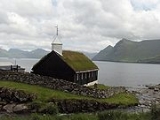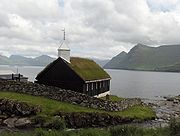
Funningur
Encyclopedia


Faroe Islands
The Faroe Islands are an island group situated between the Norwegian Sea and the North Atlantic Ocean, approximately halfway between Scotland and Iceland. The Faroe Islands are a self-governing territory within the Kingdom of Denmark, along with Denmark proper and Greenland...
. It is located on the north-west coast of Eysturoy
Eysturoy
Eysturoy means East island and is the second-largest of the Faroe Islands in the North Atlantic, both in size and population. It is separated by a narrow sound from the main island of Streymoy. Eysturoy is extremely rugged, with some 66 separate mountain peaks, including Slættaratindur, the...
(62°17′17"N 6°58′2"W). It was the only village in the municipality called Funnings kommuna, which on 1 January 2009 became part of Runavíkar kommuna.
To the west of the village rises the highest mountain in the Faroe Islands: Slættaratindur
Slættaratindur
Slættaratindur is the highest mountain in the Faroe Islands, at an altitude of 882 metres. It is located in the northern part of Eysturoy, between the villages of Eiði, Gjógv, and Funningur....
(882m).
Tradition says that the first viking
Viking
The term Viking is customarily used to refer to the Norse explorers, warriors, merchants, and pirates who raided, traded, explored and settled in wide areas of Europe, Asia and the North Atlantic islands from the late 8th to the mid-11th century.These Norsemen used their famed longships to...
who settled on the Faroe Islands settled in Funningur. His name was Grímur Kamban, a Norwegian
Norway
Norway , officially the Kingdom of Norway, is a Nordic unitary constitutional monarchy whose territory comprises the western portion of the Scandinavian Peninsula, Jan Mayen, and the Arctic archipelago of Svalbard and Bouvet Island. Norway has a total area of and a population of about 4.9 million...
Viking
Viking
The term Viking is customarily used to refer to the Norse explorers, warriors, merchants, and pirates who raided, traded, explored and settled in wide areas of Europe, Asia and the North Atlantic islands from the late 8th to the mid-11th century.These Norsemen used their famed longships to...
escaping the tyranny of the Norse king Haraldur Hárfagri
Harald I of Norway
Harald Fairhair or Harald Finehair , , son of Halfdan the Black, was the first king of Norway.-Background:Little is known of the historical Harald...
. However, this is an error in this saga, because Harald's age was in the late 9th century, while the first Norse settlers reached the Faroes after 825. (Actually, Irish monks
Papar
The Papar were, according to early Icelandic historical sources, a group of Irish or Scottish monks resident in parts of Iceland at the time of the arrival of the Norsemen...
arrived much earlier ca. 625–650).
About 70 people live in Funningur on both sides of a cascading stream in a compact cluster of houses around a small bay. The wooden turf-roofed church in Funningur
Funningur Church
Funninger Church, in the village of Funningur, is one of the 10 old wooden churches in the Faroe Islands. It was inaugurated on 30 November 1847 and is for that reason the newest of the old traditional wooden churches. Porkeri Church was also inaugurated in 1847 but a few months...
dates from 1847 and stands at the water's edge.
Mountains surrounding the village (counter-clockwise from the north):
- Middagsfjall (601m) (due north)
- GráfelliGráfelliGráfelli is the second highest mountain of the Faroe Islands located on the island of Eysturoy. It has an elevation of 856 metres. Slættaratindur just south-east of the mountain is 26 metres higher at 882 metres, the highest point of the Faroes....
(856m) - SlættaratindurSlættaratindurSlættaratindur is the highest mountain in the Faroe Islands, at an altitude of 882 metres. It is located in the northern part of Eysturoy, between the villages of Eiði, Gjógv, and Funningur....
(882m) (due west) - Vaðhorn (780m)
- Blámansfjall (792m) with outcropping NónNonNon, non or NON can refer to:* French equivalent to English "no"; Italian equivalent to English "not"; Latin equivalent to either "not" or "no"...
(504m) - Húsafjall (697m) (due south)
External links
- Faroeislands.dk: Funningur Images and description of all cities on the Faroe Islands.

